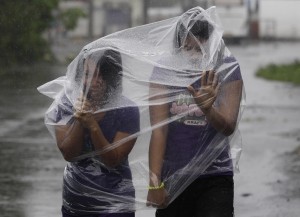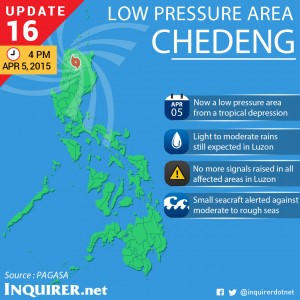Palace happy, relieved Chedeng now just an LPA
MANILA, Philippines — Good news from Malacañang. Initially classified as a supertyphoon before it was downgraded to a tropical depression, “Chedeng” was downgraded further to just a low pressure area as it was leaving the Philippine area of responsibility, or PAR.

Filipino residents use plastic sheets to protect them from rains and strong winds brought by Typhoon Hagupit in Legazpi, Albay province, eastern Philippines on Sunday, Dec. 7, 2014. Typhoon Hagupit slammed into the central Philippines’ east coast late Saturday, knocking out power and toppling trees in a region where 650,000 people have fled to safety, still haunted by the massive death and destruction wrought by a monster storm last year. (AP Photo/Aaron Favila)
Citing the Philippine Atmospheric, Geophysical and Astronomical Services Administration, or Pagasa, Communications Secretary Herminio Coloma reported earlier on Sunday that that the storm had finally made landfall on Dinapigue town in the province of Isabela and weakened further into a low pressure area.
At the same time, he relayed a “message of thanks” from Alexander Pama, executive director of the National Disaster Risk Reduction and Management Council (NDRRMC), who cited various sectors of society, including mass media, in disseminating vital information about Chedeng, the country’s latest weather disturbance.
Speaking during the weekly “Pilipinas, Pilipinas” public affairs program over state-run Radyo ng Bayan, Coloma also accepted the challenge of United Nations Secretary General Ban Ki-moon to make disaster risk reduction, or DRR everyone’s business in disaster-prone countries like the Philippines.
The Palace official called DRR one of the top priorities of the Aquino administration.
Responding to a question by the Philippine Daily Inquirer, he pointed out that disaster risk reduction was “one of the pillars of the Philippine Development Plan.”
Article continues after this advertisement“In the highest level of government, we have a Climate Change Cabinet cluster that oversees climate change and adaptation programs,” said Coloma.
Article continues after this advertisementThe government “has also come up with a national strategy on disaster risk reduction and management,” apparently referring to the National Disaster Risk Reduction and Management Action Plan for 2011 to 2028.
“During the past five years, the administration has also been implementing the National Disaster Risk Reduction and Management Act of 2010,” said Coloma.
He agreed with Ban, who had said raising public and institutional awareness on DRR could be done.
According to Coloma, that campaign was already a work in progress in the country.
“Simula po sa pinakamataas na antas sa national level, bumababa ito sa bawat rehiyon at sa bawat isa sa 82 lalawigan at bawat isa sa mahigit sa 1,600 na munisipalidad, bukod pa sa mga siyudad ng ating bansa,” he said.
He stressed the need to make DRR a household word, particularly those in disaster-prone areas nationwide.
During the just-ended Third World Conference on Disaster Risk Reduction (WCDRR), held last month in Sendai, Japan, Ban vowed to “continue mobilizing the necessary resources to make DRR everybody’s business in the Philippines and other disaster-prone nations.
However, he admitted that “it would require some time” to make DRR a household word.

Ban expressed hope that with the WCDRR and the UN agency’s continuing efforts, “both the public and private sectors will be able to pay more attention and invest more wisely in DRR areas.”
Sen. Loren Legarda, one of the leaders of the Philippine delegation to the conference told the INQUIRER that “on a scale of 1 to 10, with 10 being the highest, it’s only a 3 for the Philippines,” as far as the level of the people’s awareness of DRR was concerned.
“I think we have a long way to go,” she said, adding “sometimes people forget about DRR and slide back. So constant reminder is needed.”
Social Welfare Secretary Dinky Soliman, who headed the Philippine delegation to the WCDRR, said they were doing their part in “making sure DRR becomes a household word by making sure the households in DRR-hit areas have access to the basic needs – food and non-food items.”
For his part, Pama, also a former Navy chief, asserted with what he called a “whole society approach,” all sectors of Philippine society can increase their commitment to strengthen resilience to disasters.
“And help the poorest and most vulnerable people manage disaster risks,” he added. SFM/AC